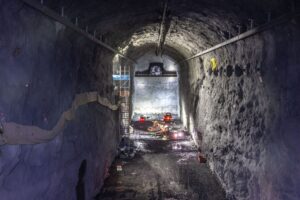Excavation work for the new DUNE neutrino detector has been completed at a former mine in Lead, South Dakota. More and more, Nikhef is involved in DUNE.

In the process, more than 800 million pounds of rock have been removed for a complex six soccer fields in size. The detectors are the size of a seven-story building and will eventually be filled with liquid argon, in which passing neutrinos occasionally leave tracks.
DUNE should be operational by 2028. The experiment will observe neutrinos produced by Fermilab’s accelerator in Batavia, 1,300 kilometers away in Illinois. These particles fly straight through the Earth’s atmosphere toward the detector in South Dakota, some of which interact with argon.
Neutrinos are nearly massless elementary particles that hardly interact with other matter. They fly virtually unhindered by matter. Neutrinos exist in three varieties and constantly change identities: electron, muon and tau neutrinos. Fermilab will produce anti-muon neutrinos for the experiment.
Neutrinos are an essential part of the Standard Model of particle physics. Their properties are still puzzling, partly because they are so difficult to measure. For example, their masses and mass ratios are not well known.

Nikhef has long been closely involved in ProtoDUNE, a preparatory project at CERN in Geneva, says project leader Paul de Jong.
For DUNE, Nikhef sees opportunities mainly in the construction of the so-called near detector at Fermilab, to characterize the neutrino beams that are then picked up in the far detector in South Dakota. PhD student Marjolein Van Nuland-Troost worked on the argon-detector prototype at Fermilab for a month last year.
. For DUNE, Nikhef sees opportunities mainly in the construction of the so-called near detector at Fermilab, to characterize the neutrino beams that will then be picked up in the far detector in South Dakota.
The work at Nikhef mainly involves researchers from the Neutrino Physics section, which also builds and operates, for example, the KM3NeT neutrino detector in the Mediterranean Sea. In it, cosmic neutrinos are studied.